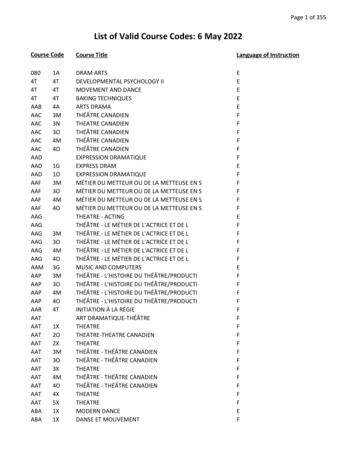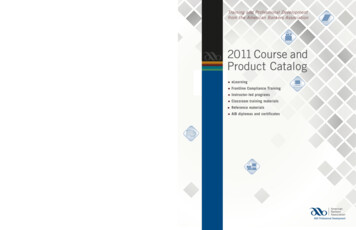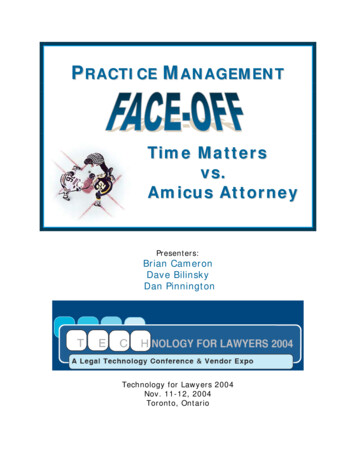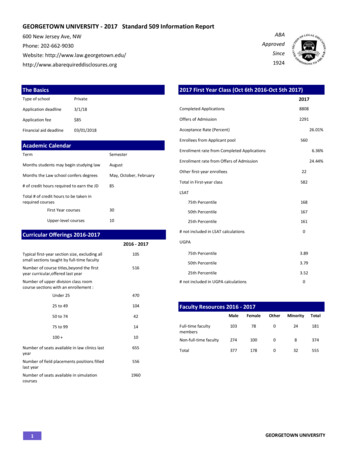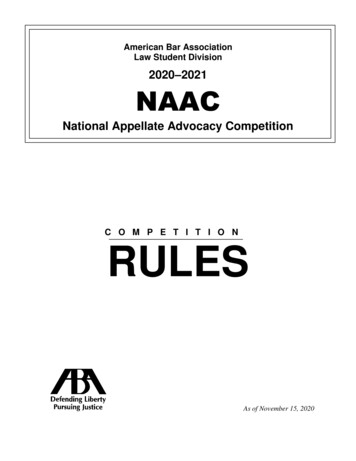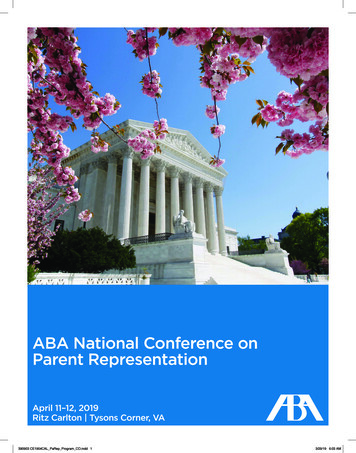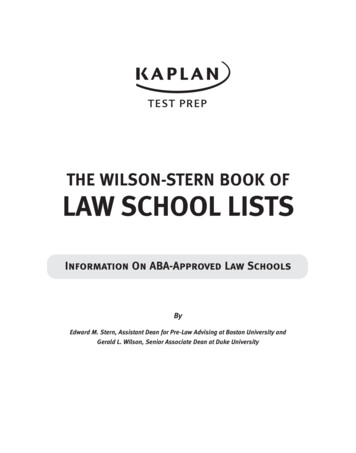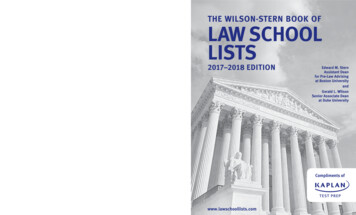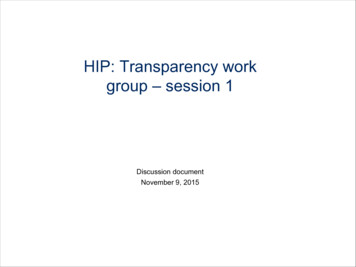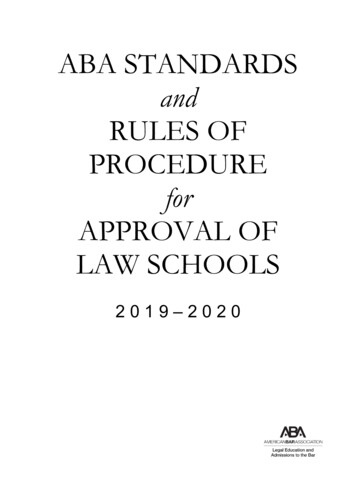
Transcription
ABA STANDARDSandRULES OFPROCEDUREforAPPROVAL OFLAW SCHOOLS2019–2020
The ABA Standards and Rules of Procedure for Approval of Law Schools are promulgated by the Councilof the ABA Section of Legal Education and Admissions to the Bar and concurred in by the ABA House ofDelegates. 2019 American Bar Association. Permission is granted to reprint, but not for profit, all or part of thispublication, provided reference is made to this publication. All other rights reserved.To order copies of this publication contact the ABA Service Center at 800.285.2221 or order online atwww.ShopABA.org. The ABA product code number for this publication is 529010919ED. The price forthis publication is 15.00.This publication is also available in its entirety at the Section’s Web page: www.americanbar.org/legaled.Printed in the United States of America.Cataloging-in-Publication Data is on file with the Library of Congress ISBN: 978-1-64105-512-3Discounts are available for books ordered in bulk. Special consideration is given to state bars, CLEprograms, and other bar-related organizations. Inquire at Book Publishing, ABA Publishing, American BarAssociation, 321 N. Clark Street, Chicago, Illinois 60654-7598.www.ShopABA.org
ContentsPreface . vDefinitions .ix2019-2020 Standards for Approval of Law Schools . 1Appendix 1: Statement on Academic Freedom and Tenure . 43Appendix 2: LSAC Cautionary Policies Concerning LSAT Scores . 45Rules of Procedure for Approval of Law Schools . 47Criteria for Foreign Summer and Intersession ProgramsOffered by ABA-Approved Law Schools in a Location Outside the United States.77*Criteria for Approval of Foreign Semester and Year-Long Study Abroad*Programs Established by ABA-Approved Law Schools .85Criteria for Accepting Credit for Student Study at a Foreign Institution . 95Section Bylaws . 99Internal Operating Practices **.113* Revised August 2019 - View Revised Criteria Here** Revised November 2019 - View Revised IOP's Hereiii
PrefaceScope of Accrediting AuthorityThe Council of the American Bar Association Section of Legal Education and Admissions to the Bar(Council) is recognized by the United States Department of Education (USDE) as the accreditor of firstprofessional degree in law (J.D.) programs. Further, with very few exceptions, in all bar-admittingjurisdictions in the United States, a J.D. degree from an ABA-approved law school is sufficient to meet theminimal education requirements established by a jurisdiction to qualify a person to sit for the barexamination. In most jurisdictions, an ABA-approved law school J.D. degree is a necessary credential toqualify to sit for the bar examination. Whether a jurisdiction requires education at an ABA-approved lawschool is a decision made by a jurisdiction’s highest court and its bar admission authority and not by theCouncil or the ABA. The Council and the ABA believe, however, that every candidate for admission to thebar should have graduated from a law school approved by the ABA and that every candidate for admissionshould be examined by public authority to determine fitness for admission.The Council’s recognition as a USDE-recognized accrediting agency was established in 1952. USDErecognition criteria require an accrediting agency within a professional association to operate separatelyand independently of the association of which it is a part. Therefore, it is the Council, and not the AmericanBar Association that is the formally recognized accreditor. Nonetheless, for ease of reference, law schoolsaccredited by the Council are referred to as “ABA-approved.” While the ABA supports the Council and itswork in a variety of ways, including financially, “separate and independent” means, at a minimum, that theABA is not involved in any way in the approval of a law school or the enforcement of the ABA Standardsfor Approval of Law Schools against law schools, including findings of non-compliance, imposition ofsanctions, or withdrawal of approval.The ABA’s interest and role in supporting legal education began in 1879, when the Standing Committeeon Legal Education and Admissions to the Bar was established as one of the ABA’s first committees. In1893, the Section of Legal Education and Admissions to the Bar was established as the Association’s firstsection. In 1921, the ABA promulgated the first Standards for Legal Education. At the same time, the ABAbegan to publish a list of ABA-approved law schools that met the ABA Standards.In its role as the “accreditor” and “approver” of law school programs, the Council has beenpromulgating and enforcing standards for nearly a century. The Standards contain the requirements a lawschool must meet to obtain and retain ABA approval. In their current form, the Standards often includeInterpretations that provide additional guidance concerning the implementation of a particular Standard.The Rules of Procedure govern the accreditation process and the process through which decisionsconcerning the status of individual schools are made. The Rules also contain provisions related to theoperation of the Office of the Managing Director.v
ABA Standards and Rules of Procedure for Approval of Law Schools 2019-2020viRevisions of the Standards, Interpretations and Rules of Procedure through 1996The Revisions of the Early 1970sA major revision of the 1921 Standards was undertaken in the early 1970s. After an extensive commentprocess, the revised Standards and the Rules of Procedure were adopted by the Section of Legal Educationand Admissions to the Bar in August 1972 and were approved by the ABA House of Delegates in February1973. A major revision of these standards occurred in 1989 as the result of the work of the RamseyCommission, chaired by Judge Henry Ramsey, Jr., of the Alameda County, California, Superior Court andChair-Elect of the Section.Wahl Commission, Department of Justice Consent Decree, and 1996 RevisionsThe Council had commenced a comprehensive review of the Standards and Rules in 1992. In April 1994,the Council had established the Commission to Study the Substance and Process of the American BarAssociation’s Accreditation of American Law Schools, which was chaired by Justice Rosalie E. Wahl ofthe Supreme Court of Minnesota, and a former chair of the Section. The Wahl Commission’s mandate wasto conduct a thorough, independent examination of all aspects of law school accreditation by the ABA. Itprepared a report and recommendations that were ready for consideration at the 1995 ABA Annual Meeting.However, in June 1995, the United States Department of Justice filed a civil antitrust suit against the ABA,alleging violations of antitrust laws in the ABA law school accreditation program, and the review of thesechanges was put on hold.The litigation was concluded by a final Consent Decree (June 1996). It included requirements forreview of the Standards. The Consent Decree was in force for a period of ten years and expired by its ownterms on June 25, 2006. The Council has determined, however, that it will continue to observe thesubstantive provisions of the Consent Decree.The Consent Decree required that the ABA establish a special commission to determine whether theStandards, Interpretations, and Rules of Procedure should be revised in some respects. It was agreed by theDepartment of Justice and the ABA that the Wahl Commission’s mandate would be enlarged to includethese matters and that the Commission’s tenure would be continued. In response to this additional mandate,in November 1995, the Wahl Commission submitted a supplement to its August 1995 report.A revision process that the Council had begun in 1992, then incorporated into the work of the WahlCommission in 1994, and which had continued and was enlarged in response to the Consent Decree in1996, led to a set of standards and rules of procedure that were approved by the Council and concurred inby the ABA House of Delegates in August 1996.Review of the Standards, Interpretations, and Rules of Procedure Since 1996Review of the Standards and Rules is an ongoing process. Each year, proposed revisions to the Standards,Interpretations, and Rules of Procedure are considered, suggestions for matters that need study are solicited,and proposed changes are subject to an extensive public comment process. Proposed revisions are carefullyconsidered in light of the comments received before any final action is taken.Further comprehensive reviews of the Standards and Interpretations were undertaken in 1996-2000 and2003-2006. A comprehensive review of the Rules of Procedure took place in 2004-2006. From 2008-2014,another comprehensive review, this time of both the Standards and the Rules, was undertaken.The Section’s website (www.americanbar.org/legaled) contains considerable history of the Standardsand the Standards review process. Visit the following pages for more al education/resources/standards/standards archives/https://www.americanbar.org/groups/legal education/committees/standards review/comp review archive/
viiABA Standards and Rules of Procedure for Approval of Law Schools 2019-2020Council ResponsibilityThe Council grants provisional and full ABA approval to law schools located in the United States, itsterritories, and possessions. It also adopts the Standards for Approval of Law Schools and the Interpretationsof those Standards, and the Rules of Procedure that govern the law school accreditation process. TheCouncil also must grant prior acquiescence in any substantive changes that are proposed by an approvedlaw school and may impose sanctions for noncompliance with the Standards.ABA House of Delegates ResponsibilityIn August 2010, the role of the ABA House of Delegates in accreditation matters was revised to complywith new Department of Education requirements regarding appeals. Prior to August 2010, a school that wasdenied provisional or full approval by the Council was able to file an appeal to the House of Delegates. TheHouse of Delegates could either concur in the Council’s decision or refer that decision back to the Councilfor further consideration. A decision of the Council was final after referral from the House of Delegates amaximum of two times in the case of decisions denying provisional or full approval, or once in the case ofdecisions to withdraw approval from a school. The 2010 changes removed any authority or role for theABA House of Delegates with respect to the approval or removal of approval of a law school.The House of Delegates continues to play a limited role in the revision of the Standards and Rules ofProcedure. The House’s role is called “concurrence.” Changes adopted by the Council are referred to theHouse, which may “concur,” in which case the changes become effective at the adjournment of the ABAmeeting where the changes were reviewed, or “refer back,” in which case the changes do not becomeeffective and are returned to the Council for further consideration. If the Council confirms the changes thatit had previously adopted, the changes are returned for a second review by the House of Delegates. If theHouse does not concur in this review, the matter is returned to the Council. If the Council once againconfirms the changes it had adopted, the Council’s decision stands without further review by the House.This Book Includes: The 2019-2020 Standards and Rules of ProcedureThese are the current criteria that law schools must meet to obtain and retain ABA approval. The 20192020 edition reflects all changes approved by the Section’s Council and concurred in by the ABA Houseof Delegates through August 2019. Criteria for Approval of Foreign Programs and Study Abroad Internal Operating Practices (IOPs) Additional Information and GuidelinesUnder its authority to adopt rules implementing the Standards, the Council has adopted criteria for theapproval of studies or activities leading to credit for the J.D. degree that are undertaken outside theUnited States. These Criteria, for various forms that study abroad can take, are included in this book.The IOPs provide direction concerning the operation of accreditation functions and other activities ofthe Office of the Managing Director.(Available online at: https://www.americanbar.org/groups/legal education/resources/standards/) Alsoincluded in this book are Council Statements and Guidance Memos. Council Statements are positionsthat the Council has taken on various matters that do not have the force of a mandatory Standard orInterpretation. Guidance Memos are issued periodically to assist schools in coming into or remainingin compliance with the Standards.
DEFINITIONS
DEFINITIONS
DefinitionsAs used in the Standards, Interpretations, and Rules of Procedure:(1)“Approved law school” means a fully approved law school that the Council has determinedmeets the requirements of Standard 103 or a provisionally approved law school that the Councilhas determined meets the requirements of Standard 102.(2)“Association” means the American Bar Association.(3)“Branch campus” means a type of separate location at which a student may earn more thantwo-thirds of the credit hours that the law school requires for the award of a J.D.(4)“Council” means the Council of the Section.(5)“Dean” means the chief administrative officer of a law school and includes an acting or interimdean.(6)“Full-time faculty member” means an individual whose primary professional employment iswith the law school, who is designated by the law school as a full-time faculty member, whodevotes substantially all working time during the academic year to responsibilities described inStandard 404(a), and whose outside professional activities, other than those described inStandard 404(a), if any, do not unduly interfere with his or her responsibilities as a full-timefaculty member.(7)“Governing board” means a board of trustees, board of regents, or comparable body that hasultimate policy making authority for a law school or the university of which the law school is apart.(8)“House” means the House of Delegates of the American Bar Association.(9)“Interpretations” mean the Interpretations of the Standards for Approval of Law Schools.(10) “J.D. degree” means the professional degree in law granted upon completion of a program oflegal education that is governed by the Standards.(11)“Managing Director” means the Managing Director of the Section of Legal Education andAdmissions to the Bar of the American Bar Association.ix
ABA Standards and Rules of Procedure for Approval of Law Schools 2019-2020x(12) “President” means the chief executive officer of a university or, if the university has more thanone administratively independent unit, of the independent unit. If a law school is not part of auniversity, “president” refers to the chief executive officer of any entity that owns the lawschool, if there is such a person, or else the Chair of the Board of Directors of the law school.(13) “Probation” is a public status indicating that a law school is not being operated in compliancewith the Standards and is at risk of having its approval withdrawn.(14) “Rules” mean the Rules of Procedure for Approval of Law Schools.(15) “Section” means the Section of Legal Education and Admissions to the Bar of the AmericanBar Association.(16) “Separate location” means a physical location within the United States: (1) at which the lawschool offers J.D. degree courses, (2) where a student may earn more than sixteen credit hoursof the school’s program of legal education, and (3) that is not in reasonable proximity to thelaw school’s main location.(17) “Standards” mean the Standards for Approval of Law Schools.(18) “University” means a post-secondary educational institution, whether referred to as auniversity, college, or by any other name, that confers a baccalaureate degree (and may grantother degrees).
2019-2020 STANDARDS
2019-2020 STANDARDS
2019-2020 Standardsfor Approval of LawSchoolsContentsChapter 1: General Purposes and Practices .3Standard 101. Basic Requirements for Approval . 3Standard 102. Provisional Approval. 3Standard 103. Full Approval . 4Standard 104. Provision of Information by Law Schools to the Council . 5Standard 105. Acquiescence for Substantive Change in Program or Structure. 5Standard 106. Separate Locations and Branch Campuses . 6Standard 107. Variances . 6Chapter 2: Organization and Administration.9Standard 201. Law School Governance . 9Standard 202. Resources for Program . 10Standard 203. Dean . 10Standard 204. Self Study . 11Standard 205. Non-Discrimination and Equality of Opportunity . 11Standard 206. Diversity and Inclusion . 12Standard 207. Reasonable Accommodation for Qualified Individuals with Disabilities . 13Chapter 3: Program of Legal Education .15Standard 301. Objectives of Program of Legal Education . 15Standard 302. Learning Outcomes . 15Standard 303. Curriculum . 16Standard 304. Experiential Courses: Simulation Courses, Law Clinics, and Field Placements. 17Standard 305. Other Academic Study . 18Standard 306. Distance Education . 19Standard 307. Studies, Activities, and Field Placements Outside the United States . 20Standard 308. Academic Standards . 201
ABA Standards and Rules of Procedure for Approval of Law Schools 2019-20202Standard 309. Academic Advising and Support . 20Standard 310. Determination of Credit Hours for Coursework. 21Standard 311. Academic Program and Academic Calendar. 21Standard 312. Reasonably Comparable Opportunities . 22Standard 313. Degree Programs in Addition to J.D. . 22Standard 314. Assessment of Student Learning . 23Standard 315. Evaluation of Program of Legal Education, Learning Outcomes,and Assessment Methods. 23Standard 316. Bar Passage . 24Chapter 4: The Faculty .25Standard 401. Qualifications . 25Standard 402. Size of Full-Time Faculty. 25Standard 403. Instructional Role of Faculty . 26Standard 404. Responsibilities of Full-Time Faculty . 26Standard 405. Professional Environment . 27Chapter 5: Admissions and Student Services .29Standard 501. Admissions . 29Standard 502. Educational Requirements. 30Standard 503. Admission Test . 31Standard 504. Qualifications for Admission to the Bar. 31Standard 505. Granting of J.D. Degree Credit for Prior Law Study . 32Standard 506. Enrollment of Non-Degree Candidates . 32Standard 507. Student Loan Programs . 32Standard 508. Student Support Services. 33Standard 509. Required Disclosures. 33Standard 510. Student Complaints Implicating Compliance with the Standards . 35Chapter 6: Library and Information Resources .37Standard 601. General Provisions . 37Standard 602. Administration . 38Standard 603. Director of the Law Library . 38Standard 604. Personnel . 38Standard 605. Services . 39Standard 606. Collection . 39Chapter 7: Facilities, Equipment, and Technology .41Standard 701. General Requirements . 41Standard 702. Facilities . 42Appendix 1: Statement on Academic Freedom and Tenure .43Appendix 2: LSAC Cautionary Policies Concerning LSAT Scores .45
CHAPTER1General Purposes andPracticesStandard 101. BASIC REQUIREMENTS FOR APPROVAL(a)A law school seeking approval by the Council shall demonstrate that it is being operated incompliance with the Standards.(b)Approval of a law school by the Council is not transferable. A transfer of all, or substantiallyall, of the academic programs or assets of (1) a law school, or (2) a university or college of whichthe law school is a part does not include the transfer of the law school’s approval.Standard 102. PROVISIONAL APPROVAL(a)The Council shall grant provisional approval to a law school if at the time the school seeks suchapproval it demonstrates that it has achieved substantial compliance with the Standards andpresents a reliable plan for bringing the law school into full compliance with each of theStandards within three years after receiving provisional approval. In order to demonstrate thatit has a reliable plan to come into full compliance with the Standards within three years afterreceiving provisional approval, a law school must clearly state the specific actions that it plansto take to bring the school into full compliance and demonstrate that there is a reasonableprobability that such actions will be successful. A provisionally approved law school may applyfor full approval no earlier than two years after receiving provisional approval and must obtainfull approval within five years after receiving provisional approval.3
ABA Standards and Rules of Procedure for Approval of Law Schools 2019-20204(b)The Council may withdraw provisional approval if the Council determines that the law schoolis no longer in substantial compliance with the Standards, is not making adequate progresstoward achieving full compliance with each of the Standards, or is no longer able todemonstrate that there is a reasonable probability that the school will achieve full compliancewith each of the Standards within the allotted time frame.(c)If five years have elapsed since the law school was provisionally approved and the Council hasnot granted full approval, provisional approval shall terminate. Before the end of the five-yearperiod in an extraordinary case and for good cause shown, the Council may extend the timewithin which the law school must obtain full approval.(d)A provisionally approved law school shall not offer a post-J.D. degree program or other nonJ.D. degree program, offer a program in a country outside the United States, or seek to establisha separate location.(e)A provisionally approved law school shall state that it is provisionally approved in all of itsprinted and electronic materials describing the law school and its program and in any otherpublication that references the law school’s approval by the Council.(f)A law school seeking provisional approval shall make its status clear in any printed andelectronic materials describing the law school and its program and in any other publicationthat references the law school’s approval status. At a minimum, the law school shall state thefollowing in all such communications:The law school is not currently approved by the Council of the Section of LegalEducation and Admissions to the Bar of the American Bar Association and makesno representation to any applicant that it will receive approval from the Councilbefore the graduation of any matriculating student.(g)A law school seeking provisional approval shall not delay conferring a J.D. upon a student inanticipation of obtaining approval. An approved law school may not retroactively grant a J.D.degree as an approved school to a student who graduated from the law school before itsapproval.Interpretation 102-1Plans to achieve substantial compliance with any of the Standards are not sufficient to demonstratesubstantial compliance.Standard 103. FULL APPROVAL(a)The Council shall grant full approval to a provisionally approved law school if at the time theschool seeks such approval it demonstrates that it is in full compliance with each of theStandards. Plans to achieve full compliance with any Standard are not sufficient to demonstratefull compliance.(b)A law school granted approval under this Standard remains approved unless the Councilwithdraws that approval.
5ABA Standards and Rules of Procedure for Approval of Law Schools 2019-2020Standard 104. PROVISION OF INFORMATION BY LAW SCHOOLS TO THE COUNCILA
ABA is not involved in any way in the approval of a law school or the enforcement of the ABA Standards for Approval of Law Schools against law schools, including findings of noncompliance, imposition of - sanctions, or withdrawal of approval. The ABA's interest and role in supporting legal education began in 1879, when the Standing Committee
